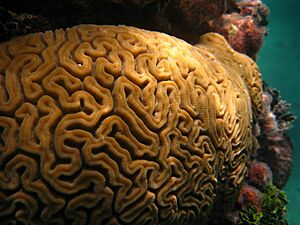Diploria facts for kids
The Grooved Brain Coral (Diploria labyrinthiformis) is a type of coral that helps build reefs. It gets its name because it looks like a human brain with its wavy, maze-like patterns. This amazing coral lives in the warm waters of the western Atlantic Ocean and the Caribbean Sea. It is the only species in its group, called Diploria.
Discovering the Grooved Brain Coral
What Does This Coral Look Like?
This coral has a round, brain-like shape. It can be brown, yellow, or grey. You can see deep, winding grooves on its surface. These grooves look like valleys and are separated by ridges. Sometimes, the valleys and ridges have different colors.
The Grooved Brain Coral grows slowly, about 3.5 millimeters each year. It can become quite large, reaching up to 2 meters (about 6.5 feet) across. When it is very young, it can move around in the water. But after a short time, it settles down and stays in one spot for the rest of its life.
How Does Brain Coral Eat?
This coral is a suspension feeder. This means it catches tiny food particles floating in the water. Its main diet includes tiny sea creatures called zooplankton and bacteria. The coral uses small tentacles to grab its food.
These tentacles have special stinging cells called nematocysts. They help to hold the prey still. Then, the coral uses a sticky substance called mucus and tiny hairs called cilia to move the food to its mouth.
Life Cycle and Reproduction
Grooved Brain Corals are special because each coral can produce both eggs and sperm. This is called being hermaphroditic. They reproduce by releasing their eggs and sperm into the water. This process is known as broadcast spawning.
After the eggs and sperm meet and combine, tiny baby corals, called larvae, develop. These larvae float near the water's surface. Unlike many other corals in the Caribbean, the Grooved Brain Coral releases its eggs and sperm over several months. This usually happens from late spring through mid-autumn.
Where Does This Coral Live?
You can find the Grooved Brain Coral in warm, tropical waters. It lives in the western Atlantic Ocean, the Gulf of Mexico, and the Caribbean Sea. It is also found near southern Florida, the Bahamas, Bermuda, and the coasts of Central America.
These corals usually live in offshore waters. They can be found at depths from 1 meter (about 3 feet) down to 30 meters (about 98 feet).
Why Is This Coral Important?
The Grooved Brain Coral plays a vital role in its ocean home. Scientists can study the layers in its skeleton. These layers help them understand how ocean temperatures have changed over many years. This information is very important for learning about our planet's climate.
Protecting the Grooved Brain Coral
For a long time, the Grooved Brain Coral was listed as a species of "Least Concern" on the IUCN Red List. This list helps track how endangered different species are. However, in 2021, its status changed. It was moved to a higher risk category.
This change happened because scientists expect its numbers to drop. One big reason is a serious illness called Stony coral tissue loss disease. This disease can harm many corals, including the Grooved Brain Coral. Protecting these corals is important for healthy ocean ecosystems.
Friends, Foes, and Neighbors
Corals live in busy underwater worlds. They interact with many other creatures.
Helpful Partnerships
The Grooved Brain Coral has a special partnership with tiny algae called Zooxanthella. These algae live inside the coral. The coral gives the algae a safe home. In return, the algae make food for the coral using sunlight, a process called photosynthesis. This food helps the coral grow.
Another helpful friend is the long-spined sea urchin. These urchins eat other types of algae that might grow too much. By doing this, they help make sure the coral gets enough sunlight and space to thrive.
Who Eats the Brain Coral?
Even though corals have stinging cells, some animals still eat them. Predators of the Grooved Brain Coral include:
- Snails and slugs (gastropods)
- Marine worms (polychaetes)
- Sea urchins
- Starfishes
- Sea spiders
- Parrotfish and other types of fish
Tiny Hitchhikers
Sometimes, tiny creatures called parasites live on or inside the coral. One such parasite is Corallovexia brevibrachium. This tiny animal can live both on the outside and inside the Grooved Brain Coral.
Brain Coral on Stamps!
The Grooved Brain Coral is so unique that it has appeared on postage stamps! You can find its image on:
- A 75-cent stamp from Belize.
- A 15-cent stamp from the United States, released on August 26, 1980.
- A 54 Euro cent stamp from Mayotte.
See Also
- Brain coral
- Colpophyllia natans (another type of large-grooved brain coral)
Images for kids
-
Grooved brain coral showing signs of black band disease in the Caribbean Sea, Bahia de la Chiva, Puerto Rico.



